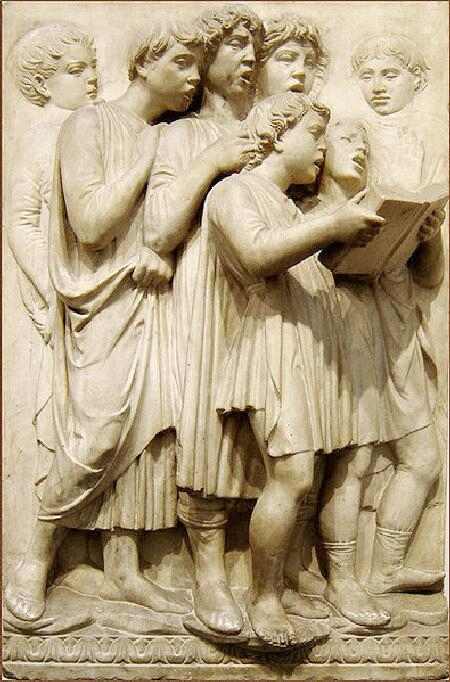
Church Choir Archictecture

Figure 1.--This was one of the pannels decorating the "Cantoria" (singing loft) for the Cathedral of Florence (1431-38). These pannels shows children singing, dancing, and making music to "praise the Lord" in the words of Psalm 150. Their figures are beautifully crafted by Luca della Robbia. It was his first known commission. This pannels seems to depict choristers at the Cathedral, although we are not positive about this.
|
|
The modern term choir meaning a group of singers has taken its name from the area of the church occupied by the singers. At different periods of church archetecture. It came to designate two distinct areas. There have also been differences assocaited with the type of church. The choir appeared as a result of the liturgical development which occurred once Constantine ended the Empire's persecutions of Christians. This meant that Christians no longer had to find secluded sites and worship quietkly. Over time the choir migrated from its origina position east. The choir area of the church or cathedral mighjt be equipped with brenches or in some cases carved and decorated wooden seats known as choir stalls. Some of these stalls are finely carved masterpieces. Here the choristers are situated during the service.
Early Churches
The area of the church mid-way between the upper end, or sanctuary, occupied by the higher clergy, and the lower end, or naive and isles, occupied by the laity. Early Church architecture generally connected the sanctuary directly to the nave. The choir was basically just the eastern part of the nave. It was often separated by low railing, called cancelli. The early church was especially a Roman institution and thus architectural terms are of course in Latin. The cancelli
was the origin of the English term "chancel". Gradually the choir became an important architectural element of important churches. The development of the choir was related to the liturgical development which occurred once Constantine ended the Empire's persecutions of Christians. This meant that Christians no longer had to find secluded sites and worship quietkly. The rise of mosasticism was another factor in the liturgical development of the early Church. Is it at this time that the term "choir" first appears in the writings of the Church fathers. Isidore of Seville and Honorius of Autun claim that term "choir" was inspired by the term "corona"--the small circle of clergy or singers who surrounded the altar. The earliest choirs were directly attached to the bema or presbytery. This was an elevated platform set in the center of the nave. Here seats were placed for the higher clergy and a usually included a lectern for Bible readings. A good example of this it the Basilica of St. Mary Major in Rome.
Medieval and Later Churches
In later churches the choir migrated to the upper or eastern end of the church. The bema or presbytery gradually shifted and the choir was moved eastward to its current position. In some churches the choir is located in the apse behind the altar.
This included the high alter and aspe. There is some variance as to the precise location. Some important European cathedrals have a retro-choir, meaning that it was located behind the High Altar. THus it opens opening eastward towards the chapels (chantries) in the eastern-most area of the cathedral rather than to the congrgants. As the choir reached its current location, the architectural details were affected by its function. It was where the Divine Office was chanted by the monastic brotherhood or the chapter of canons. The pulpit and lectern was also found in this area. Some cazthedrals have a second free-standing lectern in the center of the central isle that faced the sanctuary. The organ might be situated here or also in a loft variously situated. The choir area of the church or cathedral mighjt be equipped with brenches or in some cases carved and decorated wooden seats known as choir stalls. Some of these stalls are finely carved masterpieces. Here the choristers are situated during the service. We also notice the "Cantoria" (singing loft) in some medieval chutrches. We are not sure how common this was.
HBC

Navigate the Historic Boys' Clothing Web Site:
[Return to the Main Choir page]
[Introduction]
[Activities]
[Biographies]
[Chronology]
[Cloth and textiles]
[Clothing styles]
[Countries]
[Topics]
[Bibliographies]
[Contributions]
[FAQs]
[Glossaries]
[Images]
[Links]
[Registration]
[Tools]
[Boys' Clothing Home]
Created: 12:15 AM 11/24/2008
Last updated: 12:16 AM 11/24/2008



